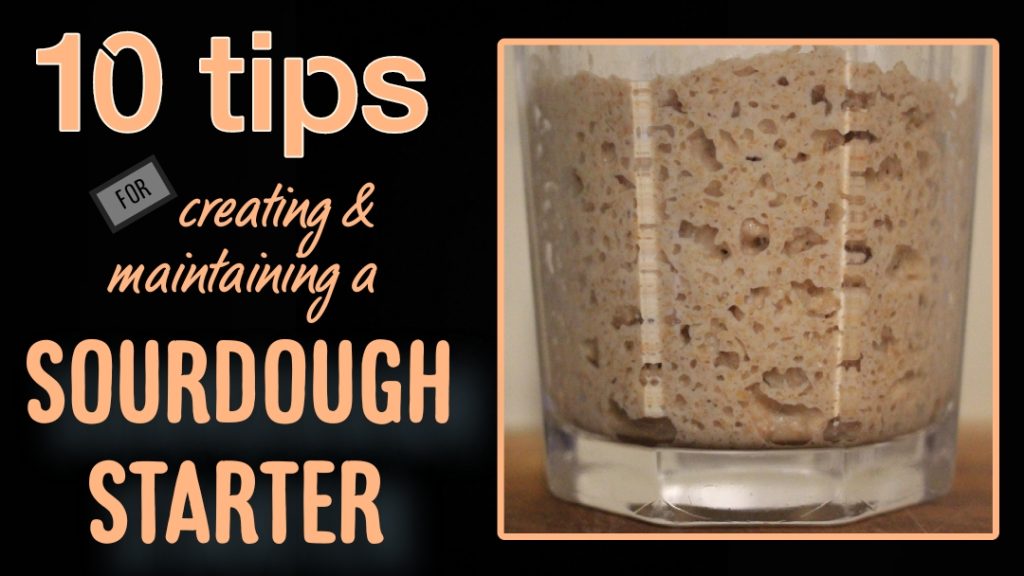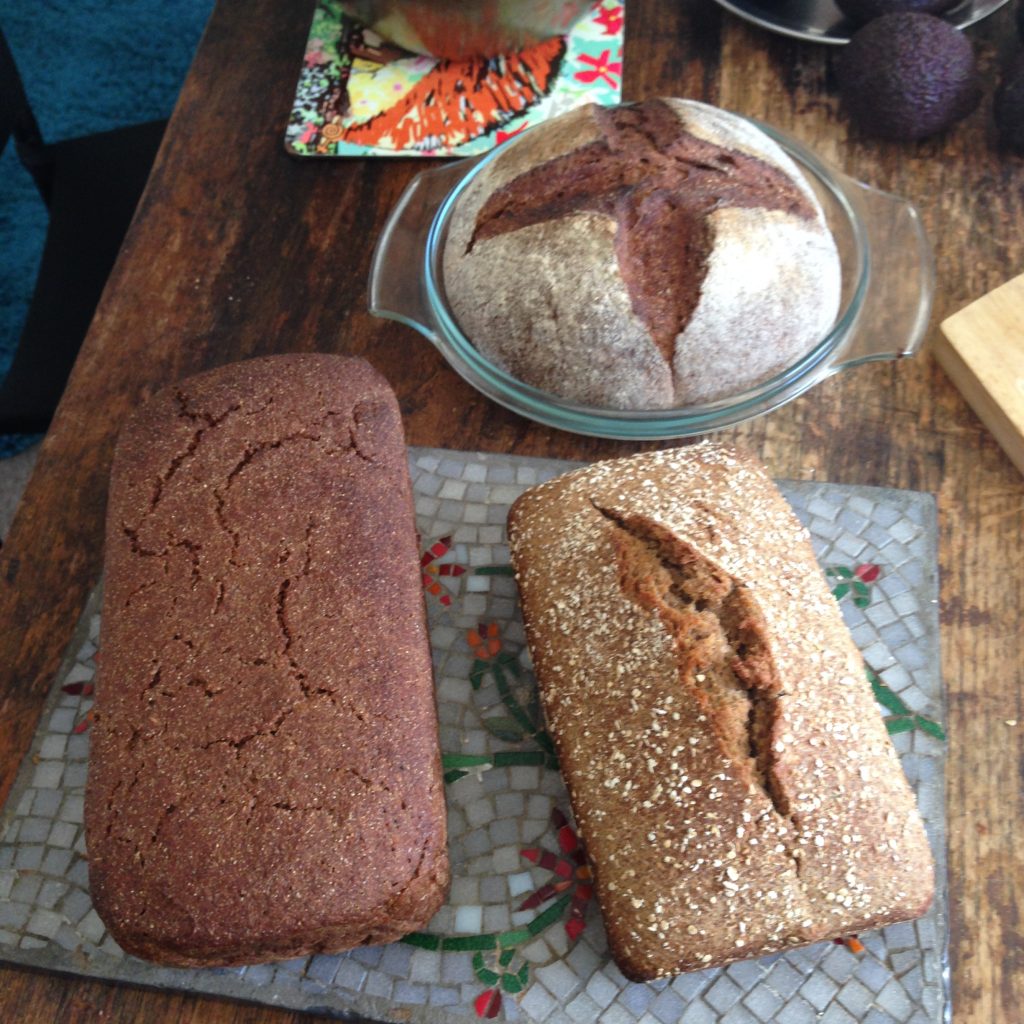There are a lot of articles out there telling you how to create a sourdough starter. Despite this, as a sourdough baker, the most questions I get asked are about sourdough starters. I’ve birthed a lot of starters over my bread-making time, and I want to share with you what I consider to be the most fool-proof method.
What you will need:
Flour – Wholegrain rye flour has always worked best for me and is routinely the flour I use to build and feed starters. I would recommend that you try very hard to get hold of some. To create a starter, you’ll need about at least 500g of flour, to be safe, get yourself 1kg. If wholegrain rye was not possible, my next choice would be another wholegrain flour – like spelt or wheat.
Water – Chlorine kills the bacteria/yeast you are trying to nurture when creating a starter, so use filtered water, buy mineral water, boil your water and let it cool, or pour your water out the night before and leave it to stand. All of these reduce its chlorine content.
Jars – These should be made of glass, with necks wide enough for you to be able to get a spoon in and stir. You’ll also need lids for them, although these can be improvised with pieces of cloth and elastic bands. You’ll need at least 2 jars, as we’ll use a clean one every time we feed the starter.
Kitchen scales – Ideally these would be digital.
A Warm Place – Your starter will grow best in a warm environment. I have found 22C/72F works well, but it could be warmer. You will often struggle with anything lower than 20C/68F. If your house is not that warm, work on finding a way to keep the starter warm. You can read my article How to Keep Your Sourdough Starter Warm for advice.
You will also need:
A consistent routine. Building a starter requires a small amount of attention at least once a day. Find a way to work this into your routine so that you do not forget. That is easier said than done if you hide your starter away in a warm spot like an airing cupboard. So put a note on your noticeboard, write it in your diary, set the alarm on your phone or put a note in your bread box. Do whatever you need to do to help you remember. You will not need to keep this up for ever, just for a week or two.
Patience. Starters take time. Don’t expect to be baking bread for at least a week, and probably more like 10 days. See it as an opportunity to work on honing you patience. (And know that you can make sourdough discard pancakes long before you can make bread, so you will get to create something!). In addition to this wait, starters often they look like they might have ‘died’. Invariably, they haven’t. Just. Keep. Going.
Here’s how:
On days 1, 2 and 3 we will work on our starter just once a day. This should be at the same time each day, so that your starter is resting for 24 hours each day. I find it easiest to work on the starter in the morning, first thing.
Day 1
Put a clean glass jar on your scales and weigh in 50g non-chlorinated water plus 50g of wholegrain rye flour. I find it helpful to put the water in first, to stop flour getting stuck on the bottom of the jar. Mix these together well. It’ll be paste-like, not runny. Make sure it is smooth and there are no lumps. It’s fine to use your finger to scrape mixture off the spoon, as long as its clean. Cover the jar loosely with the lid, or with a piece of cloth and an elastic band. Put the jar into your warm place, not in direct sunlight.

Day 2
Put a clean glass jar onto your scales. Weigh out 35g of yesterday’s mixture into the new jar and add 50g of water plus 50g flour. Mix well until it is smooth and has no lumps. Cover loosely and return to your warm place.
Day 3
Do the same thing as day 2.
From day 4 onwards, we will work with our starter twice each day. The best times for this are early in the morning and late in the evening. This provides even spacing between each feed.
From day 4 onwards you can use the portion of your stater that you discard in recipes (horray!). The simplest thing to create is sourdough pancakes.
Day 4
In the morning put a clean glass jar onto your scales. Weigh out 35g of yesterday’s mixture into the new jar and add 50g of water plus 50g flour. Mix well until it is smooth and has no lumps. Cover loosely and return to your warm place.
In the evening, repeat what you did in the morning.
Day 5
Do the same as day 4, refreshing your starter in both the morning and the evening.
Day 6
Do the same as day 4, refreshing your starter in both the morning and the evening.
Day 7
Put a clean glass jar on your scales. Weigh out 25g of yesterday’s mixture into the new jar and add 50g of water plus 50g flour. Mix well until it is smooth and has no lumps. Cover and return to your warm place.
In the evening, repeat what you did in the morning.
Day 8 onwards
Continue to feed your starter as per day 7, twice a day. You should see, or soon start to see, it rising and falling predictably. Leave it somewhere you can clearly see the changes and note after how many hours it reaches its peak and when it starts to fall. A rubber band around your glass jar can help you track this. The aim here is to get to know your starter. You’ll want to bake with it when it is at its peak. If you know how long after a refresh this happens, you’ll have the best chance of getting your sourdough loaf as good as it can be.
If your starter rises well, predictably, and falls predictably, it’s most likely ready to bake with!
Again, have patience. If it is not ready, keep going. Don’t bake until you can see it behaving predictably.
Often day 3 has a surge of activity and then things seem to die back afterwards. This is normal – just stick to the schedule and keep going.
Often it’s easier to see how the process works. If you’d like a easy-to-follow and colourful graphic of this process, you can find one I drew here. This graphic also shows how to maintain your starter after you’ve built it.
And if you’d like 10 video tips on creating and maintaining a sourdough starter, you can access my $5 course at The Fermentation School here!

If you are having issues with your starter after day 8-10, review the following:
1 – Have you been keeping it at around 22C/72F?
2 – Have you been refreshing it as per the schedule?
3 – Have you been using wholegrain rye flour?
4 – Have you been using non-chlorinated water?
If all the above are true, then employ patience and continual twice a day feeding for a few days. If, after more time, the starter is not looking active then talk to someone who has done this before and give them the full details of the measurements. flour, water and temperature you have been using. Ask for their advice, most sourdough bakers (including me) are more than happy to help. I have also found www.thefreshloaf.com extremely helpful.


Bring ancient grain baking into your kitchen!
Download my free 30-page guide with five healthy and tasty 100% ancient grains recipes.


Hello Alison
when can you start dropping the feeding of the starter?
Im at day 7 and it started doubling in size today, or do you feed it twice a day indefinitely?
Thank you
Kelly
Hi Kelly. Great that it’s doubling in size! I would keep it at two feedings a day for a few days and watch it. If you can see it acting consistently (use a rubber band to help if you need to) then you can 1/ use it to bake (hurrah!) and then 2/ go to a maintenance routine (you can view how I do that here: https://ancestralkitchen.com/2022/02/07/sourdoughstartergraphic/)